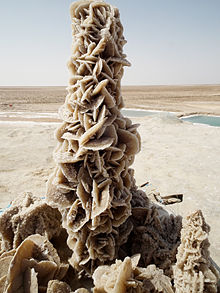
ROSE ROCKS (r![]() z r ä k) are crystal formations of barite, or a type of gypsum called selenite. When the crystals form, surrounding grains of sand are incorporated into the structure. The composition of the sand varies with the environment.
z r ä k) are crystal formations of barite, or a type of gypsum called selenite. When the crystals form, surrounding grains of sand are incorporated into the structure. The composition of the sand varies with the environment.
BARITE ROSES (“ROSE ROCKS”) are found in Egypt and Oklahoma. The Egyptian variety is yellow (from the sulfur in the sand) and their blades are more square than the Oklahoma variety.
The Oklahoma barite rose’s base chemical composition is BaSO4, + Fe and various elements that are present in the sand that they form in. They rank around 2 or 3 hardness on the Mohs scale. The iron in the sand gives it not only its characteristic color but also causes the blades to round off. This form of rose rock is almost exclusively unique to Noble County, Oklahoma.
Allegedly, there is “an old Native American legend” that says Oklahoma rose rocks formed from the blood of the Indians on the Trail of Tears. However, research to determine where that legend originated seems to indicate that it was probably made up sometime in the 1960s by people wanting to capitalize on tourism, and new age collectors asking about metaphysical properties.
In fact, rose rocks long predate human habitation. They were “…formed during the Permian Period, 250 million years ago, when western and central Oklahoma was covered by a shallow sea. As the sea retreated, barite precipitated out of the water and crystallized around grains of quartz sand. This left behind large formation of reddish sandstone, locally called Garber Sandstone, containing deposits of rose rock.” (From Wikipedia: Desert Rose)
SELENITE ROSES (“DESERT ROSE” or “GYPSUM ROSE”)

Selenite roses are found in Australia, Algeria, Saudi Arabia, United Arab Emirates, and throughout the southern U.S., including Oklahoma and Texas.
Selenite roses are found across the world, but barite rose rocks are found almost exclusively in Oklahoma. Selenite roses typically have thinner and sharper plates than the barite stones.
Metaphysical Properties
Barite roses are used to establish a connection to the spiritual realms, particularly ancestor work, helping to facilitate communications beyond the veil.
Barite is used in radiology and because of this association both barite roses as well as the single crystals called “petals” or “coins” can be utilized to help discern knowledge that would otherwise remain hidden.
Selenite roses are used to access spiritual planes, but they are also noted for their abilities to heighten perception and are popular with healers. They have all the associations of selenite, but can also be used to help move past stuck patterns and old habits that are no longer useful.
Well-shaped roses are associated with the heart chakra, and are said to help draw romance, fortify existing relationships, and strengthen friendships.
Barite roses are particularly effective in sex magic because of their similarity to female genitalia. Barite nodules (“male” rose rocks) can be used in this work as well due to their resemblance to the testes. If used for a couple, stones corresponding to the genders involved should be chosen. When used in sex magic, they align with the root chakra.
Care and Cleansing
Rose rocks should be cleaned gently, as they can be fragile. Rinsing in water and gently scrubbing with a soft toothbrush should be enough for most cases. Do not leave selenite roses in water for long periods of time, since selenite will dissolve.
Both barite and selenite roses are self-cleaning, but a thorough cleanse and recharge can be achieved by holding the stone over the smoke of burning incense or sage.
Do not drink water that has been in contact with rose rocks of either type.
We also have it available at our brick and mortar shop.